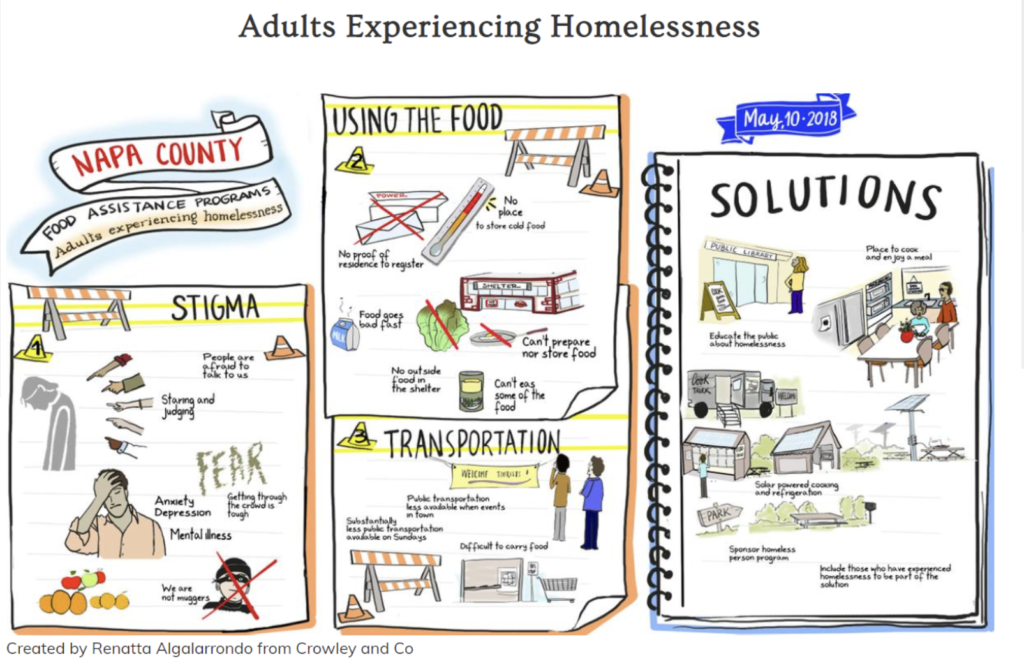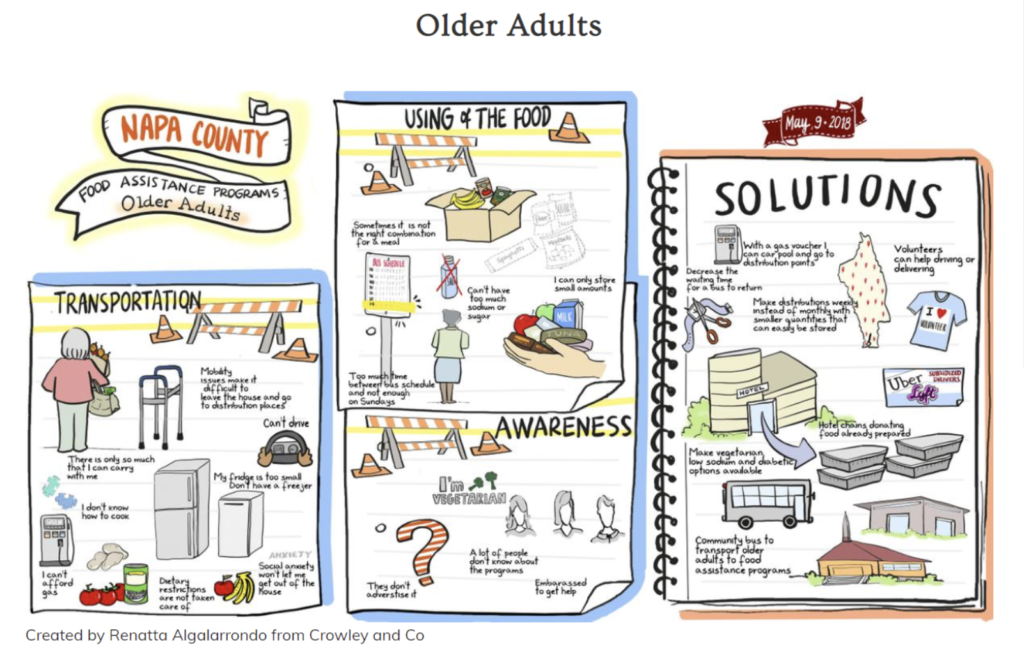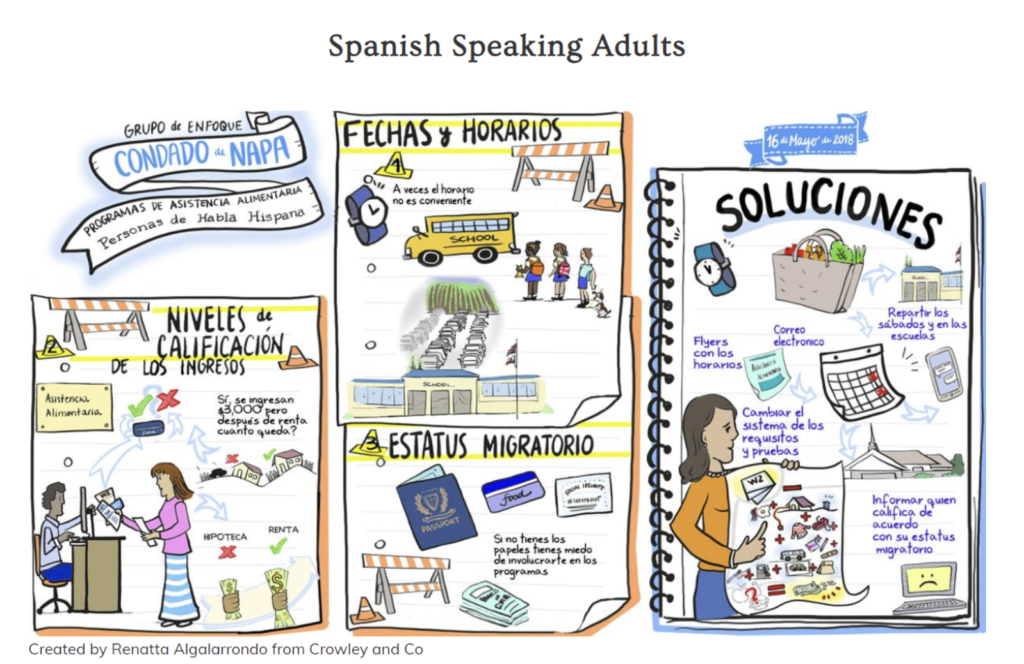Seeking Long Term Solutions to Food Insecurity & Chronic Illness
The Population Health Innovation Lab partnered with Live Healthy Napa County to decrease food insecurity through a Community of Practice approach
Live Healthy Napa County (LHNC) serves as the county’s Accountable Community for Health (ACH), a public-private-community partnership working to promote and protect the health and well-being of every member of its community.
In 2016, LHNC enlisted the Population Health Innovation Lab (PHIL) to identify upstream solutions to community factors contributing to chronic disease in Napa County. LHNC focused on food security- ensuring access to fresh and affordable healthy foods. Lacking access to healthy, nutritious food is a community-level social determinant of health and is linked to increased risk for obesity, type 2 diabetes, cardiovascular disease, and other health conditions.
As sense-makers in the community health space, PHIL drew on design-thinking methods, systems change practices, and a proven track record as community conveners to create a Community of Practice (CoP). A CoP is a structured series of workshops intended to improve participants’ skills and knowledge in a subject area. In this instance, PHIL taught the LHNC leaders how to engage priority populations, including elderly adults, community members who had been unhoused or homeless, and low-income Spanish-speaking adults. These community members were identified as those who would benefit most from the emergency food system and were most reluctant to access these resources. The CoP then set out to understand why—and do something about it.



PHIL reached out to community-based organizations, service providers, youth organizations, donors, unhoused individuals, youth, Spanish-speaking immigrants, first-responders, businesses, food truck drivers, church groups, food banks, and the elderly to inform the project. PHIL team members talked to people, listened to them, and, most importantly, got people talking to one another.
PHIL connected with more than 40 partner organizations, hosted over 25 learning conversations, and administered 351 surveys to identify hundreds of local assets. Community members who had experienced food insecurity spoke frankly about why they were reluctant to take advantage of emergency food services—providing answers to the questions which had long evaded the service providers. Before these PHIL facilitated conversations, community members hesitated to speak frankly for fear of appearing ungrateful. Power dynamics also reinforced reticence. These listening sessions broke down those barriers and created a space for constructive conversations to take place.
PHIL and LHNC produced valuable insights that could inform specific ways to remove barriers to access and engage priority populations. In some cases, service providers learned that any food that couldn’t be eaten in a single sitting by homeless program participants went to waste. In other instances, the availability and hours of food pantries created access barriers. A lack of transportation and childcare were identified as reasons for limited access.
Successful improvements were made to program services, system coordination, and service expansion for interconnected providers from different sectors all working together to address food insecurity in Napa; these successes would not have been possible without these bi-directional insights.
Outcomes
Data gathered during the study support five key recommendations to address barriers to food security in Napa County:
- Awareness: First, access required a “just the facts” baseline. Multi-lingual, multi-media, regular communication of information on available emergency food assistance programs and services, eligibility criteria, and location-date-time.
- Awareness & Stigma: In addition, a stigma-busting awareness campaign needed to be layered on top of this effort. Human-centered stories to decrease stigma around food insecurity aim to cultivate empathy among fellow residents and potential donors.
- Transportation: Minimize transportation barriers by expanding food access locations and leveraging existing place-based spaces.
- Using the Food & Stigma: Large economic anchor institutions in the community— healthcare, education, government institutions—could support access to healthy food for all residents.
- Fundraising: Non-profit service providers should explore ways to engage individual, institutional, and private industry donors in funding opportunities via new and emerging technology such as social networks and crowd funding tools.
Visit the Napa County site to explore the study findings.
RELATED RESOURCES
- Spotlight on Community Engagement: Live Healthy Napa County
- Napa County Emergency Food System Study: Final Report
- Finding Barriers and Solutions to Combating Food Insecurity in Napa County
- Participatory Leadership for Community Inclusion: A Report of a Community of Practice Focused on Community Engagement
- Service: Multisector Collaborative Development and Support
- Service: Meeting Design and Facilitation
- Service: Research and Evaluation



